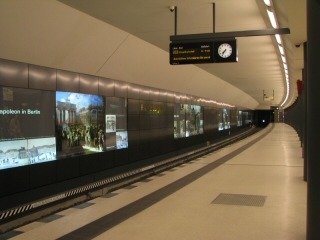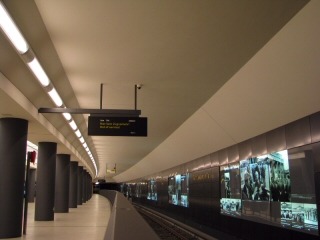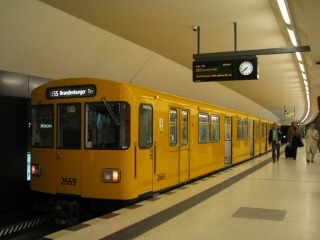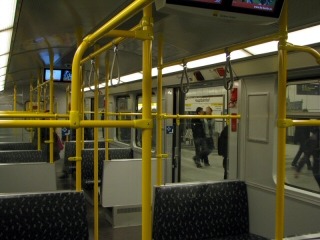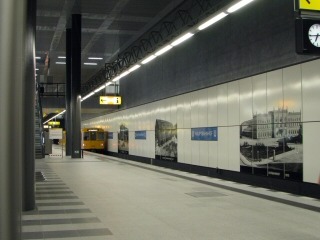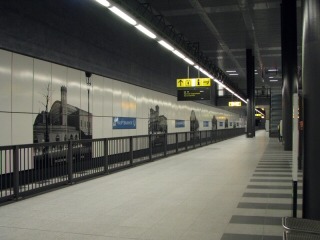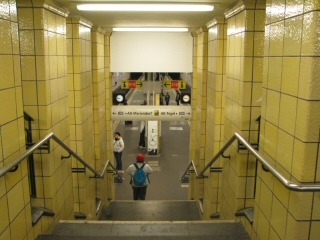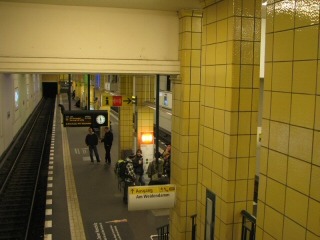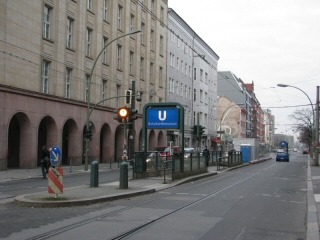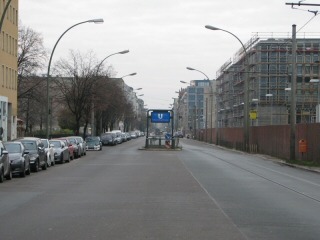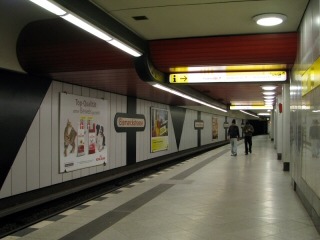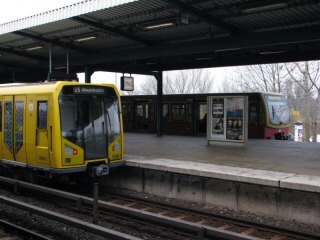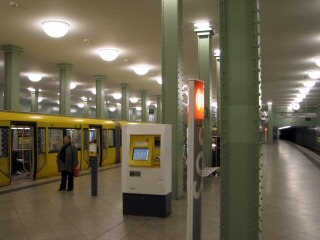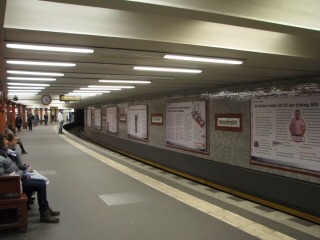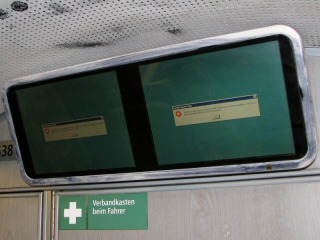budapest
other hungarian
close-up
lost rails
other countries
A bit of Berlin U-Bahn II.
I know, my previous travelogue about the narrow-profile U-Bahn lines was far from complete, and this one won't be extensive on the wide-profile ones, either... so much to see, so little time! I tried to pick a few interesting parts out of the lot, though :)
U55 - "The Chancellor's U-Bahn"
One would imagine that the capital of one of the leading economies of the world could afford new U-Bahn lines at any given time, but that's not entirely true. The unification of East- and West-Germany has put a huge burden on german public finance, and plans for a long-needed westward extension of the existing U5 line were shelved after construction works have already started around the proposed new central railway station (Hauptbahnhof) and the reinstated political center of the country, the Bundestag. The new stretch was to connect the north-west quarters of Moabit to the traditional East-Berlin city center stretching between the Brandenburg Gate and Alexanderplatz. The line was planned to utilize new tunnels built next to railway and street tunnels built for/in accord with the new Hauptbahnhof. The already built underground facilities were used for movie shootings and theater shows for a few years, until the federal government threatened Berlin to revoke federal funds already used up for the line.
This argument seems to have worked, and the shortest U-Bahn line of Berlin was opened in 2009. It's 1.8 kilometers long, has two termini and only one inbetween stop (Bundestag). Since it has no direct connection to other lines, it received a separate designation: U55. Because in its current form traffic is moderate, only one of the two tracks is used by a single train-set shuttling up and down between Brandenburger Tor and Hauptbahnhof! To the left: the serviced platform of the Brandenburger Tor station. To the right: the other - currently unused - track.
Four two-car units were assigned to this route, out of which mostly two are used in a set. Some of my friends reported to have seen a triple-set (six cars), but at the time of my visit, only a two-car was operated. At the Hauptbahnhof end of the tunnels there's a modest workshop facility - if greater repairs are due, the vehicles have to be lifted out of underground with a crane.
It was strange to see such a short train at the quite large station at Hauptbahnhof!
The Hauptbahnhof station features large pictures of all the former railway stations of Berlin - most of which are gone now.
Since most wide-profile lines were built later than the narrow-profile ones, they tend to feature simpler architecture - especially the ones built after World War I. But that does not mean they're ugly!
The Friedrichstrasse station of the U6 line. This must have been one of the weirdest places during the existence of the Berlin Wall: the stop was located inside East-Berlin, but the line itself was connecting the southern parts of West-Berlin to the northern parts of West-Berlin. Through traffic was retained, and there was a possibility of transfering to S-Bahn lines also acting as transit from and to West-Berlin via East-Berlin. Inhabitants of West-Berlin were allowed to move within the transfer area freely, but of course East-Berliners were denied this. Of course East-Berlin did not allow this usage upon mere generosity: the usage of East-Berlin tunnel facilities by West-Berlin services was an important source of "hard" currency for the economically failing socialist state!
I noticed several mice looking for food in the ballast, they were quite cute :)
As I said, U6 was a transit line in (under) East-Berlin, but the only open station was Freidrichstrasse - all others were blocked and guarded. Using these so-called "ghost stations" was out of the question: if a (West-Berlin) train got stuck under East-Berlin, passengers were not allowed to evacuate it simply by foot through the tunnel - they had had to wait for a rescue train escorted by eastern border guards/security. The stations on the photos above - Naturkundenmuseum and Schwartzkoppfstrasse have lost their disctintive blue signs for those years - not to mention that these lines were entirely missing from East-Berlin maps! Note that these stations were built under the road surface with a middle platform isle and direct access to the surface via stairs - this was to make construction less expensive.
In East-Berlin, trams and S-Bahn were the backbone of public transit, while in West-Berlin they have abolished trams, and because it was operated by the East-German state railways, they also avoided usage of the S-Bahn, promoting U-Bahn to public transportation means number one. The new stations were modern, but not necessarily nice - like the Bismarckstrasse station of U7 (to the left). To the right: East-Berlin had only built a few U-Bahn extensions, and one of them included the Wuhletal station jointly used by U- and S-Bahn lines. I really liked this interoperation: "U" on this side of the platform, "S" on the other, and then the same in the other direction, too.
A short video of how a really good transfer station should function like :)
Alexanderplatz has three U-Bahn stations (for U2, U5 and U8), connected to a labyrinth of underground passages - it was one of the places were I almost managed to get lost :) To the left: the station of U5 is simple, but spacious (with four tracks). To the right: the station of the U2 features more of those nice glazed tiles so typical for the Berlin U-Bahn.
To the left: the interior of a wide-profile U-Bahn car. The strange seat covers and the repeating patterns of Berlin landmarks on the windows are meant to prevent graffiti and window scraping. To the right: this PID had problems displaying its intended contents. I'm very sorry for being childish, but I could not resist taking a photo of this :)
That's all for now - hopefully next time I'll have more time to spend in Berlin than just one and a half days!
Back to the top Back to the main page
